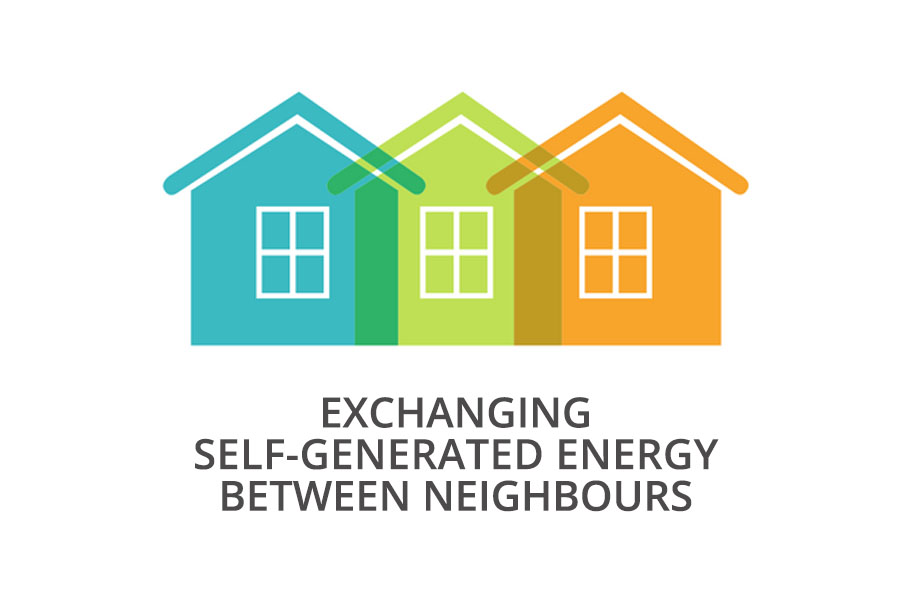In the United States, exchanging self-generated energy between neighbours is already a reality. The project is still experimental, but the creation of communities that produce and exchange clean and local energy will represent a real revolution in the field of sustainable development.

For now, there are small pilot experiments intended to be tested in Europe and Italy. In these local communities, each home is connected to a neighbourhood area network, called Smart Grid, in order to produce and exchange energy.
Families or residential units sign contracts where they agree to connect to the Smart Grid with their neighbours, share the self-generated power and use energy from other homes according to their needs.
The system is managed by a software that ensures security, a constant flow of energy, avoiding waste and theft of energy. The software uses cutting-edge technology, with capabilities and features similar to the computer systems used on financial trading platforms. Therefore, this technology is extremely safe, innovative and fast.
The benefits of this type of cooperation between neighbours are many:
- Energy saving: the use and the consumption of energy are optimized with a network that distributes energy according to individual needs.
- Environmental sustainability: increasing the development of renewable energies and reduction of CO2 emissions. The energy produced and exchanged is clean energy coming from renewable sources, such as photovoltaic systems. Energy is also created and reused locally, with less impact on the territory in terms of infrastructure and lower operating costs for the energy distribution network.
- Optimisation of energy storage and storage methods. Each home will no longer have to worry about how to store the surplus of energy since it will put it on the network to be exchanged with other homes.
With this system and the connection to Smart Grids, it will be possible for a family to have enough energy to use electrical devices, household appliances, for domestic heater systems and to produce hot water.
In the future, Smart Grid applications will not only be used for the distribution of energy for household use but will also be used, for example, to power the batteries of electric cars.
Smart grids: what they are and how they work
Let’s take a closer look at how the network works. This network will allow connecting homes to each other. The Smart Grid is a group of small networks and as its name suggests it, these networks are intelligently interconnected. Smart Grids distribute energy more efficiently, with cables that prevent overloading, waste and voltage fluctuations. They replace old energy distribution systems that we’re familiar with, consisting of one power supplier and many consumers. Smart Grids function as an equal network where manufacturers and consumers are on the same level and work together to better manage the system.
The management software that will allow Smart Grids to function properly will track the energy flow of the entire network at all times and will assess the cost of energy, deciding to collect energy from sources with lower costs.
Smart Grids: the benefits
Smart Grids consist of the main network and many small connected networks that reach each household. Compared to self-generating energy in a single residential unit, being part of a network of interconnected homes will be of great benefit in terms of reliability and quality.
Families connected to each other will be able to count on an uninterrupted flow of energy, which will always be available at any time. The energy supply will be flexible and will be able to adjust according to the needs, seasons or to a particular moment of a day. With this new perspective, homes will no longer just become the centre of energy consumption, but also the place where energy is produced and exchanged, thus providing a source of income for the family.
From an even broader perspective, the regions where these autonomous energy communities will be established will gain greater value on the market. All the homes in a given area will, in fact, be equipped with modern and energy-efficient infrastructures with considerable savings in terms of electricity consumption. The house itself will gain greater value on the market, but the energy islands that will be built around Smart Grids will also benefit from an increasing market value in the real estate market.
This will encourage more and more families to join the Smart Grid system, to be part of an energy island and to transform their own home into a Smart Home in order to enhance the value of their property and the surrounding area.
Smart Grids and Smart Houses
It goes without saying that to be connected to a Smart Grid, the house will have to become more and more a Smart House. In other words, the interior will have to be designed and equipped with specific appliances and systems in order to satisfy the needs and requirements of those living in the house.
In a Smart House, the systems and devices are programmed directly by users; they are therefore equipped with flexible mechanisms and operate autonomously or partly autonomously. A Smart House is a more comfortable home where appliances are managed remotely with ease and speed, using a smartphone.
Smart Grids will interact with the technologies present in a Smart House. Made of cables in which data flows, these networks will be able to provide a database that homes will use as well.
Therefore, the internet and our entertainment systems at home will be able to run through Smart Grids.
In Europe, the Netherlands has been one of the first countries to believe in the system of Smart Grids and the exchange of energy between homes, implementing a project that interconnects 20,000 households that exchange energy. It is very likely that, given the positive results of this first experience, the number of connected households will continue to rise in the future.
